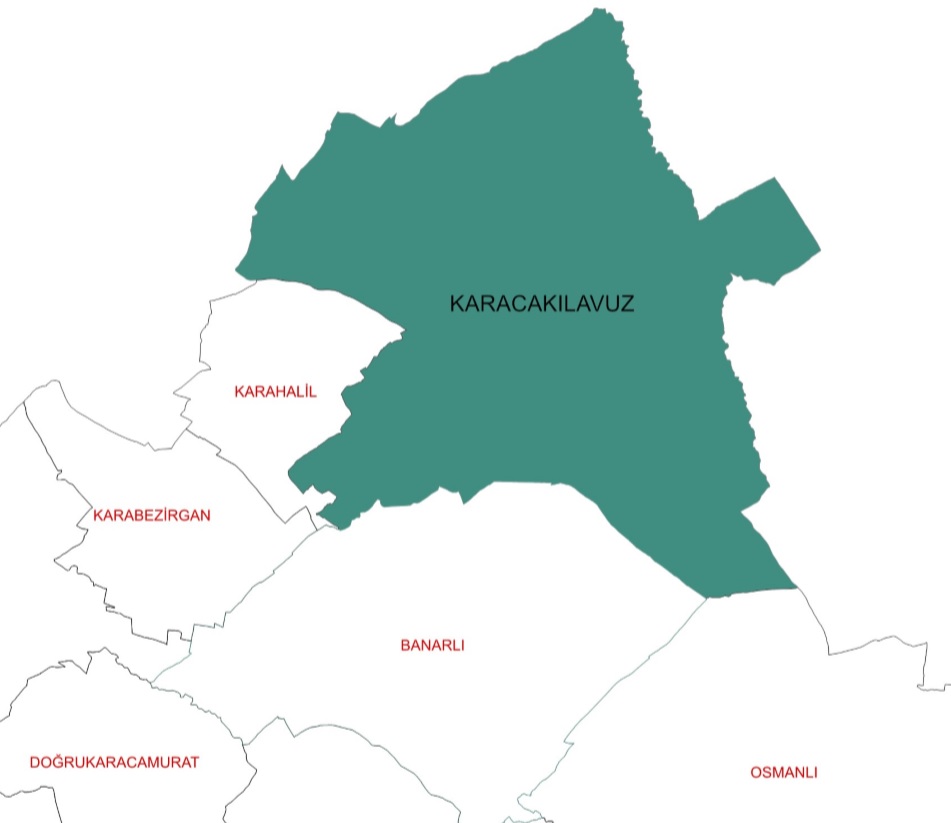

is located where the administrative borders of Karacakılavuz, Süleymanpaşa, Hayrabolu and Muratlı districts intersect, 32 km from the city center, 32 km from Hayrabolu and 24 km from Muratli. For transportation by personal vehicles, you can follow the Tekirdağ-Hayrabolu road and pass through Banarlı or follow the Tekirdağ-Muratlı road and reach Yeşilsırt-Aydınköy. The population in 2019 is 2,818 people.
History
Karacakılavuz was founded in 1884-85 by the immigrants who migrated from the villages of Krushevo (Krushva) and Sennik (Çadırlı) in the town of Sevlievo (Selvi) in Bulgaria. It is said among the people that in the 15th century, people were forced to migrate to Bulgaria from the Konya-Karaman region as a result of the policy of Turkification of the Balkans.
It is known in various sources that Karacakılavuz was one of the fiefs of Koca Mustafa Pasha, one of the viziers of the times of Fatih and Sultan Bayezid. In addition, the oldest date on the tombstones found in the cemetery in the town today is 1730 AD. According to these tombstones, it is understood that this area belonged to a family called "İbrahimzade". While Karacakılavuz was affiliated to the Büyükkarakarlı sub-district of the Hayrabolu district in the years it was founded, it was later attached to the Banarlı sub-district.
According to the legend about the name Karacakılavuz, a group of hunters came to the place where the town is established today, after a roe deer they were chasing, and, being amazed by the beauty of this place, they began to refer to it as "Karacakılavuz", which means "the place where the deer guides and brings". The name was used in old correspondences such as karacakulavuz, karacakuloğuz, but after the 1930s, it took its current form. Until 1924, the village was managed by two muhtars, one headman from Khrushva village and one headman from Çadırlı village. The names of the mayors are:
Dual Mukhtar Period:
Mimar Sinan and Central District (Krusha Districts):
1.
2. Gege Ahmet (1884)
3. Danduk Hüseyin (1900)
4. Salihağaların Ziya (1904)
5. Bilal Çavuş (1912)
6. Köse Ahmet (1920)
Zafer District (Çadırlı District):
Sakir Pehlivan (1884)
Osman Pehlivan (1900)
Hüseyin Pehlivan (1908)
Osman Aga (BÜKE) (1920)
Single Mukhtar Period:
1.
2. Ömer Ağa (1924)
3. Yaşar Ağa (1926)
4. Ferhat Çavuş (PEKEL) (1930)
5. (Aliş) Bilal SOLAK (1934)
6. Şakir (Bey) ÖZER (1946)
7. Raşit GILBAZ (1947)
8. (Kadı) Hüseyin HELVACI (1950)
9. (Körboğlu) Mehmet KÖRPE (1954)
10. Şerif Mehmet BOZKURT (1956)
11. Mehmet ESİRGEN (Öğretmen-1960 darbesi atamayla)
12. Ahmet KARACA (atamayla)
13. Yaşar GÜLLÜ (1962)
14. (Avcı) Ahmet HELVACI (1969)
It became a town with the establishment of the municipal organization on June 6, 1971.
The names of the mayors and the parties they belong to are as follows:
1.
2. Osman ÖZER 1971-1973 Cumhuriyetçi Güven Partisi (CGP)
3. Yaşar GÜLLÜ 1973-1977 Adalet Partisi (AP)
4. Osman ÖZER 1977-1980 Cumhuriyet Halk Partisi (CHP)
5. Ayhan ÇEVİK (Ara dönem)
6. Hüsmen ZIHLI (Ara dönem)
7. Şerif OKUR (Ara dönem)
8. Ahmet KAMBUR 1984-1989 Anavatan Partisi (ANAP)
9. Mustafa ÖZER 1989-1994 Sosyal Demokrat Halkçı Parti (SHP)
10. Ahmet KAMBUR 1994-1999 Anavatan Partisi-Refah Partisi(ANAP-RP)
11. Mehmet SOLAK 1999 (Belediye Meclisi Kararıyla)
12. Mustafa ÖZER 1999-2004 Cumhuriyet Halk Partisi (CHP)
13. Ömer GÜMÜŞ 2004-2009 Adalet ve Kalkınma Partisi (AK PARTİ)
14. Ömer GÜMÜŞ 2009-2014 Adalet ve Kalkınma Partisi (AK PARTİ)
With the new metropolitan law, the municipal organization was abolished and turned into a neighborhood.
There are currently 2 primary schools, health center, drinking water and sewerage network, 4 restaurants, carpet pitch and Agriculture Center in the town.
Its climate is under the influence of the Marmara climate. Summers are hot, winters are cold and rainy. Average annual precipitation varies between 500-1,000 mm.
The town reflects the general situation of Tekirdağ province in terms of product pattern. Mainly wheat and sunflower are cultivated. In addition, due to the intense animal husbandry, the production of forage crops has an important place. In addition to this, canola cultivation has been added to the product pattern in the town in recent years.
|
M2 VALUE OF THE WORKS DONE TO THE BARBAROS NEIGHBORHOOD IN 2020 |
||||||
|
TYPES OF WORK |
||||||
|
HOT ASPHALT |
ASPHALT PATCH |
DECORATIVE WALL |
CONCRETE HANGER |
PARQUET STONE NEW |
PARQUET STONE REPAİR |
OPEN OF NEW WAY |
|
5.791 |
108 |
- |
- |
- |
- |
- |